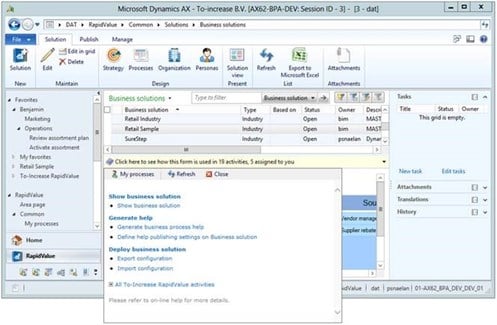In a recent blog post (see to-increase.com/blog/posts/aec-industry-trends.aspx), we reviewed some of the challenges and opportunities architecture, engineering, and construction (AEC) companies face as they apply business intelligence, social media, and collaboration technology to their operations. We also discussed AEC businesses’ need to ensure the most productive utilization of their resources and assets, especially as the construction and professional-service markets become healthier and projects often present almost unheard-of complexities. Today we take a look at how builders, architects, engineering, and professional services customers who use our solutions address these challenges through mobility, employee training, and business process optimization.
Many of the To-Increase AEC customers around the globe—companies such as Al Harbi Trading & Contracting Company, Altez Group, BBA, Groupe Segex, Grupo GP, Higgins, and Vostochnaya Tekhnika—use the To-Increase Construction Solution or our service management tool in integration with their ERP system, sometimes complemented by our other products. Another group, including Performance Contracting Group, rely heavily on To-Increase Business Integration Solutions and BPM Solutions to make their teams, processes, and systems more strategic and efficient. What they all have in common is that they use technology innovatively, sometimes in unexpected ways, and with excellent results. All of our AEC customers rely on our solutions to help them run efficient operations, deliver projects and services profitably, and use business insight to inform their growth goals, but the routes they take are highly individual.
Leveraging Mobility to Simplify and Accelerate Operations
Mobility is key for almost all of these companies, which have multiple crews in the field at any time, working on projects and delivering services to clients. They use mobile technology as much as possible to keep their people productive on profitable assignments and eliminate downtimes. Some project and field roles—superintendents, foremen, project managers, and others—perform a variety of tasks and may contribute at different project locations, so the demands on their time and efficiency are above those for the teams they supervise.
Many of our customers use mobile apps that simplify time and expense reporting, progress tracking on projects, and managing engineering change requests in providing field services on customers’ assets. These apps track GPS coordinates, and they are aware of roles, users, and projects. When an employee records time and activities, the app presents the information for the most likely projects depending on the GPS values recorded during the day. Drop-down menus feature the most likely selections for activities performed. If the worker does not need to make an exception, all it takes is a few simple steps clicks to approve. When the app automatically flags discrepancies, such as 10 hours of activities performed in an eight-hour day, users can easily verify and record the appropriate entries. As a result of this use of our technology tools, a bothersome, error-prone chore becomes very simple, and the companies’ project and back offices always have current data on how people use their time. That, in turn, is crucial for effective project reporting with resource and budget assessments.
Even a company that performs equipment maintenance services exclusively at its own facilities relies heavily on mobility to access our solution and ERP data and forms. Service managers use their smartphones to view and create work orders, queue jobs and tasks to be performed, and order parts. Because maintenance tasks and schedules are largely standardized and all the information is available on the mobile devices, there is no ambiguity as to tasks, schedule, and costs. Also, there is no wait for somebody else to initiate a parts order or schedule work. At the end of a service job, the solution shows the complete list of work performed, along with hours and parts. Billing and reconciling the maintenance information with warranty contracts are minor tasks that can all be handled from a mobile device. Customers receive their equipment back faster, and the likelihood of errors or omissions is next to zero.
Role-Based Process Guidance and Training with RapidValue
Some customers make extensive—and very creative—use of our BPM solution to streamline their operations management. Several large professional services and specialty construction enterprises employ thousands of people and often experience turnover, changing staffing levels as projects and clients demand. That means they very often have to train people in how processes and systems work. To make that effort globally scalable, they take advantage of To-Increase RapidValue. In RapidValue, they can create and manage business processes, and optimize their ERP system and other technologies to fully support these processes. As a training and employee enablement tool, these companies find RapidValue most effective. With RapidValue, it is easy to generate help documentation and make it available within Microsoft Dynamics AX, and customers also use the solution to support systems and job training.
For every business role, RapidValue can list the processes that role touches in a utility often called the MyProcess page. Employees can browse through the hierarchy of processes, understand how individual processes flow, which activities they need to perform, and how they interact with other roles and processes. Role-based favorites in RapidValue connect to the appropriate forms in the ERP system, which employees can then access at the right point in a process. RapidValue’s process-aware form guides (see illustration below) and contextual ensure that workers are never adrift and help them perform their jobs consistently.

Many To-Increase customers deliver projects and services in different countries and regions. For them, the multi-language capabilities in the latest version of RapidValue are crucial in translating process, help, and training content quickly and inexpensively into local languages.
In an upcoming blog post, we will highlight some aspects of our customers’ use of big data and business insight to pursue their strategies, make smarter decisions, and become more competitive.


